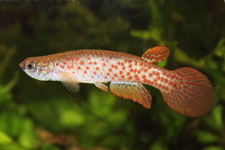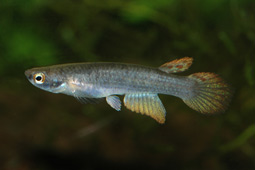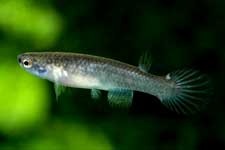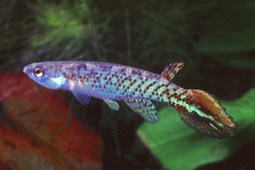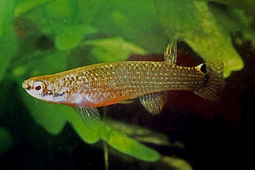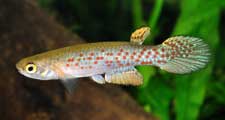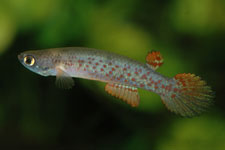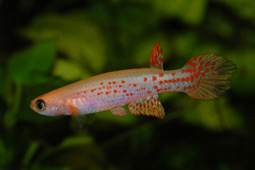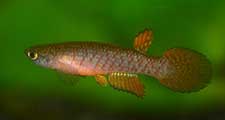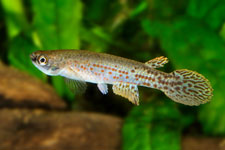History
Alternative name Anablepsoides ornatus.
In the following text you will find what was written, word by word, by Dr. Jean Huber, France, in his wonderful KilliData-Online about the difficulties scientists have with the justification of the correct name of this small Rivulus.
Killi Data is the most complete site for scientists and hobbyists on the subject of all Killies in the new- and old world. It is a must for all people who have in one or another way interest in this group of fishes and in Nomenclature in general.
Since December 2017 the site is freeand after registration you become a member of this platform and have full access to the most complete info on Killies, not only the species from South America as in this site but from all over the world.
Citate:
"Rivulus obscurus and ornatus :
This is a complicated case and a confusion due to the simultaneous publications of 2 authors (end of 1992 and beginning of 1993, without knowing the project of each other): first, the author's Rivulus book [Huber, J.H. 1992. Review of Rivulus. Ecobiogeography - Relationships. Cybium Suppl., Société Française d'Ichtyologie Publ.: 586 pp., 40 pls., 85 figs., 8 tabs, 13 maps.] where lectotypes of ornatus and obscurus are designated ; and second Costa's paper in DKG Journal [Costa, W.J.E.M. 1993. Zur Identität und Verbreitung von Rivulus ornatus und Rivulus punctatus. D.K.G. (Deutsche Killifisch Gem.) J., 25 (3): 44-46, 2 figs.] where he mentions that the true ornatus is in fact obscurus according to material from near Manaus (3.130S, 60.020W) and the aquarium ornatus is then an unknown species, without knowing the lectotype designation for ornatus from Silves, i.e. not in the area of Manaus ; this is unfortunate and lies only in the lack of communication between Costa and Huber ; but the problem actually comes from the fact that in his descriptions, Garman (1895) used several lots for ornatus with 3 different and distant localities and one lot for obscurus with a type locality near Manaus, identical with one of the 3 for ornatus : in details for ornatus, the 3 localities are Silves, Lake Saraca, N. Brazil {2.880S, 58.350W} ; Parana do Janauari, Brazil {3.200S, 60.080W} (near Manaus); Lago Cudajas, now L. Badajos, N. Brazil {3.250S, 62.780W} and for obscurus, Lago Januaria, vicinity of Manaus, N. Brazil {3.200S, 60.080W} ; by selecting Silves as the official type locality for ornatus, without knowing Costa's research,
Huber made Costa's publication inappropriate because Costa allocated ornatus to a fish we do not know if it is identical with the fish from Silves ; let's wait until live material is collected from the 2 fixed type localities, Silves for ornatus, and Januaria, near Manaus for obscurus and the issue can be fixed which, in turn, will enable to address another issue, the identification of the aquarium strains of ornatus: one as an aquarium import from Obidos (?), lower Amazon (NSC-2), Brazil {1.920S, 55.520W} and the other from Padre Isla, Iquitos, Peru {3.620S, 73.700W}"
<End of citate.>
To find a solution for all these uncertainties the only way is also to recollect the species from their original collecting localities and compare them with the material that is there. In the mean time new collecting localities are reported. One is shown in the above image. This species was given to me by Sue Katz, USA for free as I was at the 2009 TAKO convention in Houston. She told me that Ron Harlan was the one that collected this fish. I will contact him for detailed info about their origin. The second one is showing remarkable differences in the color and finnage. This one came from Thodor Metchko, Bulgaria who did send me some of the eggs he could spare. I only could raise 2 males from those eggs. According to his specifications it comes from South West Peru. No other details are given yet.
Reproduction
Keeping and breeding is not easy and a good cover of the aquarium is necessary because there ability to jump, even true the smallest opening, is unbelievable.
This species can, if there is enough space for them, housed in a tank with more males than one only and several females. If separated before and brought together again however, they can be very aggressive to each other and fight to become dominant to others. The best way to have much offspring is to put a group or an trio in a shallow tank from 30 liters with a small filter in it or with some aeration. On the bottom some peat moss or dark gravel and a floating "mop" to give space for laying there eggs. Very good results are recorded if the species has lots of Riccia fluitans or other floating plants like Azolla used as hiding places and by leaving the eggs and later the fresh born juveniles in the tank with the parents. The fish will, if they become a rich variety of small sized life food, spawn during there whole adult life and a good pair produce daily between 3 to 8 eggs.
If not set up as explained above the eggs should be collected by hand and stored for about 14 days in a small container. Eggs are 1.6 mm and amber colored. It is wise, to add to the water you store the eggs in, some acryflavine to prevent fungus coming up.
After hatching the young fry can eat fresh artemia nauplii after a week and will live also from small infusoria that are attached to the plants. It takes 4 to 6 months to raise them to maturity.
There lifespan can be up to 3 years in captivity.
Remarks :
From above the fry looks black colored and show a illuminated spot on the head like in Epiplathys from Africa. They are almost always dwelling at the surface and loose this spot after a month.
Variations
To the right the image of one of the males from Thodor Metchko, Bulgaria. With missing ventral fins.
To the right a R. ornatus without any black pigmentation. This one was born out of the strain of Sue Katz, USA.
Below R. ornatus from Caserío San Andrés and at the right from South West Peru.
At the left you see an image of Rivulus obscurus from Rio Purus, not far from Manaus, Brasil. As stated above there is an ongoing discussion about which species was given originally the name Rivulus ornatus by Garman in 1895 . Some scientists believe the fish, shown here at the left, should be named as Rivulus ornatus and the one above is a yet undescribed species.
Map
Meristics
Max. size 3.5 cm.
Dorsal 7.0,
Anal 11.0,
D/A 10.1,
LL scale count (average)30.1
Pre- dorsal length to % SL – 79.0 %
Depth to % SL – 18.0 %
Literature
Garman, S.W. 1895. The cyprinodonts. Mem. Mus. Comp. Zool. Harvard, 19 (1): 139.
Costa, W.J.E.M., 2011.
Phylogenetic position and taxonomic status of Anablepsoides, Atlantirivulus, Cynodonichthys, Laimosemion and Melanorivulus (Cyprinodontiformes: Rivulidae).
*Ichthyological Exploration of Freshwaters* 22 (3): 233-249
